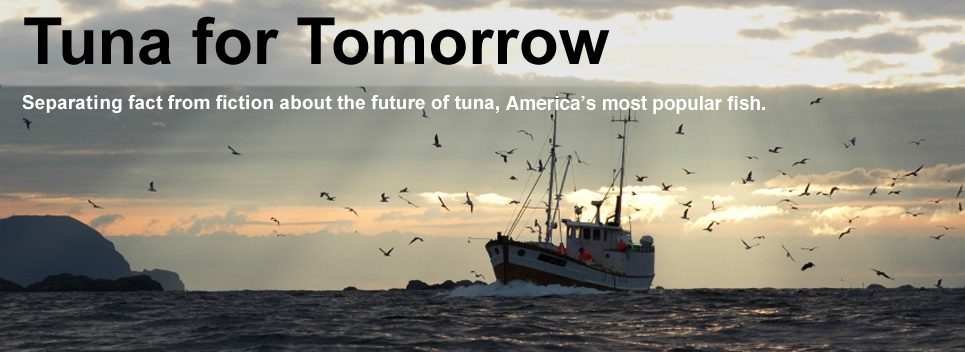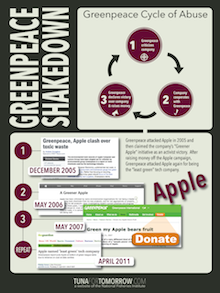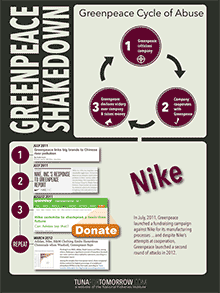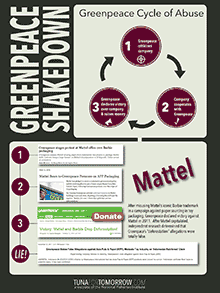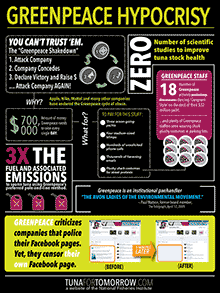from The Huffington Post
In a recent Huffington Post column, Greenpeace Board Member Jeffrey Hollander writes, “Canned tuna is not a product generally synonymous with innovation.” This is rich coming from an organization that has been using the same pressure tactics, often based on hyperbole and outright lies, for the past 40 years.
In fact, the people who put nutritious and affordable tuna in America’s lunch bags and on dinner tables have been improving the way tuna is found, caught, and kept viable for generations to come. That unheralded success has taken many years of continuous innovation and effort that will surely continue.
Consider the challenge. You are on a small boat in an ocean twice the size of Canada. In that ocean you are looking for only two species of tuna (skipjack and albacore) that roam for thousands of miles. How do you find and catch those fish and little else?
Random nets strewn about would catch everything. A fishing pole in the open ocean would catch next to nothing. Experience teaches us that migratory fish like tuna are attracted to floating objects like tree branches or logs in what is an otherwise featureless aquatic wilderness. These floating objects are known by the technical term Fish Aggregating Devices (FADs), and they make fishing for tuna more efficient. Remarkably, innovations like FADs help keep bycatch — fish caught other than tuna — to less than 5 percent of the total catch.
But no one fishing method is perfect by itself. That’s why tuna fishermen use a variety of gear. As the methods improve, the mix of gear changes. This has been true for years. And as anyone who has dropped a line in the water knows, there is no one method that is 100-percent free of bycatch.
Greenpeace’s Jeffrey Hollander also says that it is becoming harder “to hide from the reality of what is happening to our oceans.”
That’s true… and that’s good news.
What’s happening in our oceans is that fish populations once thought to be on the brink are coming back. And those still facing challenges have sustainability oversight in place. Albacore and skipjack tuna stocks are healthy and thriving. And because of FADs, tuna bycatch rates have never been lower, which means tuna fishermen can better avoid catching other species of fish or sea turtles.
The bad news is that tuna brands and retailers in the U.K. have been bullied by Greenpeace into commitments that look good on paper but do little to improve actual tuna sustainablity. In fact, Greenpeace’s “solutions” will impact the health of people dissuaded from eating tuna and may have vastly more damaging consequences for ocean ecosystems.
Greenpeace’s says it wants tuna to be caught only with a fishing pole and line, or with no FADs — in other words, with no modern fishing techniques. Think about how that might work in practice. You’d need a lot more boats covering a lot more ocean in search of tuna that could be almost anywhere. That means more engines burning more fuel for more time, enough bait to decimate stocks of bait fish, and a massive new carbon footprint.
If, in reality, this approach is such a bad idea, why does Greenpeace talk about it incessantly? The reason is simple: Greenpeace needs something to talk about.
To raise the huge amounts of money it needs to support a global anti-business organization with its ships, helicopters, blimps, plushy costumes, and media centers, Greenpeace needs a cause to get donors excited —Â not excited enough to do independent research, but just enough to write a check and move on. That’s why Greenpeace is always talking about whales, and tuna, and tigers, and pandas — what media experts call “charismatic megafauna.”
Notice how they don’t talk about dolphins anymore. Why? Because innovations in tuna fishing like FADs made canned tuna dolphin-free decades ago.
No, the best problem for Greenpeace to attack is one that features an attractive animal and an impossible solution. That way they can raise money for years to come and never actually solve the rhetorical “crisis” they created.
Followed to their logical ends, Greenpeace’s solutions would put companies out of business, and perhaps that’s the goal. But it’s not a sustainable one for Greenpeace, because without the big bad companies to rail against, supporters won’t write checks. So, look for Greenpeace to continue its full-blooded fundraising effort via a half-hearted sustainability campaign.
Gavin Gibbons is the director of media relations for the National Fisheries Institute, the nation’s largest seafood trade association. As NFI’s spokesman, he has been featured in everything from the Washington Post to USA Today and has been the voice of fisheries issues on CNN, NPR, and the Fox Business Network. He is also a featured blogger for AboutSeafood.com andSeafoodSource.com.


